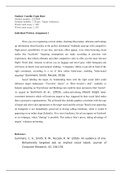Student: Camilla Tepin Rizzi
Student number: 2253488
Seminar number: 1 (Topic: Target Audience)
Word count essay 1: 248
Word count essay 2: 243
Individual Written Assignment 1
Were you ever organizing a travel online, checking Skyscanner, eDreams and looking
up information about beaches in the perfect destination? Suddenly pop-ups with competitive
flight prices, possibilities of cars hire, and more offers appear, even when browsing social
media like Facebook? Targeting assumptions are made according to previous web
experiences, that inform eDreams and other competitive sites to offer you the most relevant
flight+ Hotel deal, Amazon to advise you on luggage and travel gear, while Instagram ads
will focus on beach wear and summer clothing. Companies’ ability to get ads in front of the
right consumers, according to a set of their online behaviours, enabling “behavioural
targeting” (Summers, Smith, Reczek, 2016).
Social labeling the target, by bombarding them with the right social label could
influence target enthusiasm: “Travelers’ choice” or “Best traveler’s deal”, similarly to
banners appearing on TripAdvisor and Booking.com could be more persuasive that “tourist”.
As argued by Summers et al., (2016), online-advertising should target label-
consistent behavior which will motivate targets to buy, triggered by their social label rather
than a persuasive argumentation. The ad should also include graphics consistent with the type
of target and select sites appropriate to the target reach and the ad type. Beach wear appearing
on Instagram is not immediately perceived as having selling intentions, while it would if
appearing on an online shop (Zalando). For a travel audience, the ad can appear on Facebook
or on webpages, where “sharing” is possible. This reduces firm’s prices, taking advantage of
targets’ voluntary promoting.
Reference:
Summers, C. A., Smith, R. W., Reczek, R. W. (2016). An audience of one:
Behaviorally targeted ads as implied social labels. Journal of
Consumer Research, 43, 156-178.





